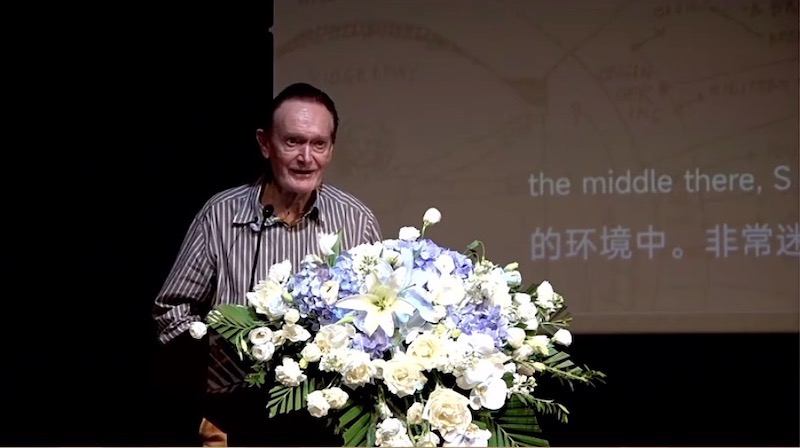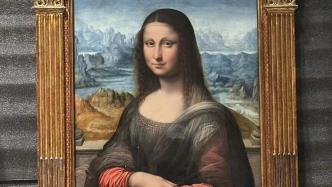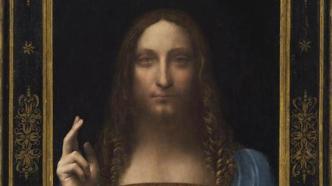
On November 15, 2017, Leonardo da Vinci's "Salvator Mundi" was sold at Christie's auction house in New York for US$450 million, becoming the "most expensive painting in history" in one fell swoop. The painting was once identified as a copy painted by Leonardo da Vinci's apprentice. When it entered the market in 1958, it changed hands for only 45 pounds. After a series of studies and restorations, scholars from various places also actively participated in discussions about the authenticity of the paintings.
Recently, Jiazuo Bookstore invited Martin Kemp, emeritus professor of the Department of Art History at the University of Oxford and a scholar of Leonardo da Vinci, to interpret his opinion on "Leonardo Da Vinci's "Salvator Mundi": Lost in Controversy". "Salvator Mundi" is an insight into the works of Leonardo da Vinci. The Paper is hereby authorized to publish part of the lecture.

Martin Kemp, Emeritus Professor of Art History, University of Oxford and Leonardo da Vinci scholar
The painting "Salvator Mundi" depicts the figure of Jesus Christ who is seen as the savior of the world. In the painting, Christ is a half-front portrait of Christ on oil painted wood, wearing a green-gold and crimson robe, holding a crystal ball in his left hand, and raising a gesture of blessing with his right hand.
At present, there does not seem to be any conclusive record that Leonardo da Vinci was commissioned by someone at any time and place to create this work. However, the existing Leonardo da Vinci manuscripts of the British royal family and a series of copy versions with the same composition prove that there must have been an "original" used for study and observation in history.
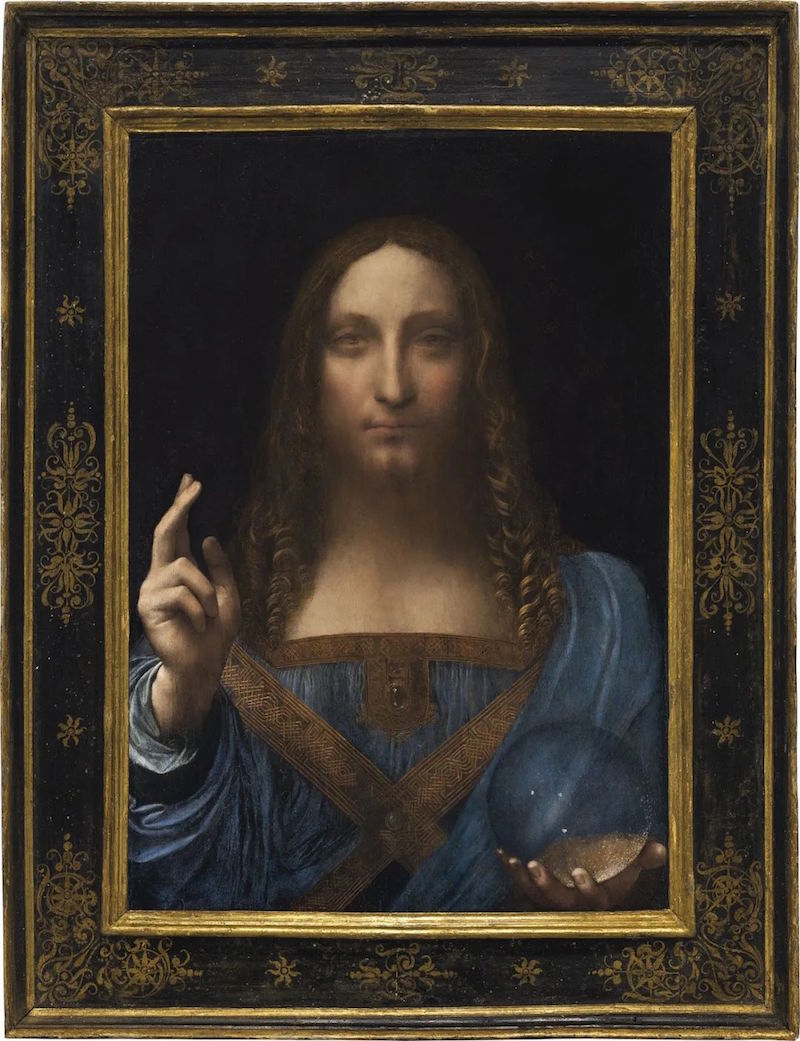
"Salvator Mundi" (Salvator Mundi), Leonardo da Vinci (?) oil on wood, 65.6 x 45.4 cm, circa 1500
The reprint of Bohemian printmaker Wenceslaus Hollar (1607-1677) in 1650 is the best proof. In the inscription below his work, Höller clearly states that it is a reproduction "from the original work of Leonardo da Vinci."
After leaving the war in northern Italy, Leonardo da Vinci entered the court service of King François I (1494-1547) of France in 1516 and died in Amboise. Scholar Luke Syson believes that this painting was most likely brought to the French court by Leonardo da Vinci during this period, and then entered the British King Charles I (1600-1649) through the marriage between England and France in 1625. ) collection. As a patron of Peter Paul Rubens (1577-1640) and Anthony van Dyck (1599-1641), Charles I was undoubtedly the top collector of the seventeenth century. Among its numerous collections of Italian art, scholars have indeed found a record that reads "A portrait of Christ painted by Leonardo, worth thirty pounds." Over the next two hundred years, similar written accounts indicate that a so-called Leonardo da Vinci Christ was circulating among the British court and upper aristocracy.

Winthrop Holler, "Salvator Mundi", engraving, 1650, now in the Thomas Fisher Rare Book Library, University of Toronto
Traces of modifications in "The Savior"
There is an obvious trace of modification (pentimento) in "Salvator Mundi". "Pentimento" means "penance" in Italian, a term that refers to a change of mind in a painting. It can be seen in several reproductions of "Salvator Mundi" that the thumb was originally supposed to be in a different position and was later redrawn to look like the thumb in "Salvator Mundi". This does not prove that the painting was painted by Leonardo, but generally speaking, a copyist would not do this, and in all other reproductions of Leonardo's paintings, the thumb appears in Another position, but there is no trace of the two thumbs, nor is it in the originally drawn position. So it is useful and inspiring to explore the original image of the surface of this panel because, as I said, this is not something you normally see on reproductions.
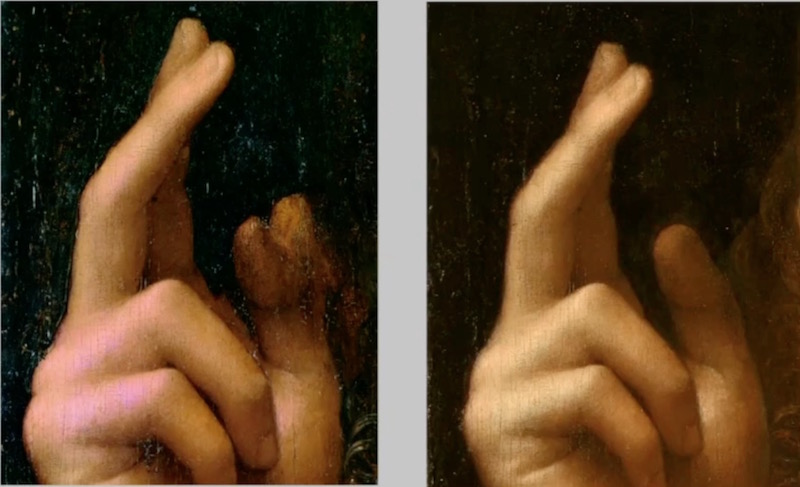
Traces of finger modifications in "The Savior"
Leonardo da Vinci was very flexible when painting. We have many infrared photos of his paintings (this is a newer technology than X-rays), so you can see the traces of his past paintings underneath the paintings, which shows that he always sees different possibilities. In comparison, Raphael was a more rigorous painter, and he would not change the composition every time he decided on it. As for Leonardo da Vinci, he could always think of different possibilities. There are many other traces of alteration in this painting, but they are already fewer than in some of his other works. The Mona Lisa was drawn by Leonardo da Vinci based on a completely proportional sketch, but even so, he still changed the position of Mona Lisa's fingers and made some other changes.
We will also notice some modifications on the front of Christ's chest. Originally these lines were curved, but what finally appeared on the painting were sharp angles. It can be seen that the painting was not originally designed with this pattern, but in the end he chose a straight-line pattern with sharp corners, and he changed the way the knot was drawn.

Traces of modifications to the clothes in "The Savior"
We also noticed that the figure in the painting has a handprint on his left eye. In order to soften the edges of his subjects, Leonardo often dipped the heel of his left hand into paint and rubbed it away. This spot on Christ's eyes is where he softens the gradients between colors and transitions between different forms, a very typical Leonardo da Vinci move. At this point, there is no way for apprentices to be as sophisticated as him. So, this mudra is very useful. Even though we can't do fingerprints or any forensic tests on it, its existence is proof of Leonardo's painting skills.
"Savior" theme
We should talk about the theme of "Salvator Mundi". This theme has a long history, but the title "Savior" was not used at that time. The name is a product of the 17th century and is not contemporaneous with the painting itself. This theme comes from images of rulers. In the golden medal of Charles V (Charles V was the emperor of the Holy Roman Empire since 1356), the sphere he holds in his hand symbolizes the "Messiah", the savior of the world. The sphere, decorated with a cross, symbolizes the world and depicts the dominion of the Holy Roman Emperor. It is therefore a secular image symbolizing dominion.

Gold medal of Charles V

Images related to Christ: (left) Monreale (centre) Rogier van Der Weyden, (right) Jan van Eyke )work
On a religious level, the image of dominion is not too different. The image on the left, on a beautiful late Byzantine dome, is the Christ Pantocrator from Monreale in Sicily, looking directly at us and blessing us , this specific gesture is just like what we saw in "Salvator Mundi". The center image is by the great Dutch artist Rogier van Der Weyden and is part of a set of triptychs. Note that you can take a closer look at the composition of these paintings that we now call “Salvator Mundi”. The image on the right, without a sphere, is from a well-known and acclaimed work by Jan van Eyke. This early master had a great influence on Leonardo da Vinci.
In addition, in the text of the Bible, you can see the following biblical passage inscribed on the image of the "Savior": "Come to me, all you who labor and are heavy laden, and I will give you rest" (Mt. Matthew 11:28) and "Jesus said, 'I am the way, the truth, and the life. No one comes to the Father except through me'" (John 14:6). This is, therefore, a benevolent image of Christ, not as a harsh judge, but as a merciful Christ. These are often passages associated with this image, so it is a gentler image of Christ than the Christ of the Last Judgment.
See the hair, patterns and crystal ball in "Salvator Mundi"
Let's take a closer look at this painting and really take a closer look at how it was painted. In all kinds of arguments, people usually don't look at the painting carefully. They just take a quick look and then immediately jump to the idea of "Oh, this is a Leonardo da Vinci painting" or "This is not a Leonardo da Vinci painting." paintings”, and it is the art historian’s job not to be swayed by these arbitrary opinions and to really look at the paintings carefully.
Let's first take a look at the hair of the character in the painting. It is very beautifully painted, reflecting the excellent line accuracy and the artist's ingenuity. This is definitely a hallmark of Leonardo da Vinci's work, as he compared the curls of hair to the movement of water. In a beautiful drawing in the Codex Windsor, he notes, "Note the similarity between the movement of water and the curl of hair," and explains that the weight of hair gives it a linear direction. The water flow also has this effect, and the water will produce ripples during the circulation, just like curly hair. Both of them are straight in themselves but have the potential to become curved. By juxtaposing the two, you can get a cone like the picture below, an extended spiral. In those wonderful paintings of the ripples created by a pole hitting water, the ripples resemble a horse's tail. When Leonardo da Vinci painted, he had a sense of the structure of objects, what I call the physical properties of hair. He is not just painting the curls of hair, but trying to understand the physical reasons that cause hair to curl by painting this appearance, just like water undulating due to certain physical principles.

Hair in "Salvator Mundi" and Leonardo da Vinci's manuscript on water flow
If we look at the angular pattern on the front of Christ's clothes, we will find that this is quite rare for Leonardo da Vinci. He usually painted curved, streamlined objects, so we are almost certain to have been influenced by Islamic art. For example, in this Islamic tile, this angular pattern is definitely Islamic. It is obtained by rotating the square 45 degrees. It is a very common decorative pattern in Islamic art and has many variations. Leonardo da Vinci was obviously very interested in this, but other painters of his generation basically continued to paint curved patterns rather than Islamic angular patterns.

The geometric figures at the intersection of the skirts of "Savior of the World"
We can conclude that Leonardo became aware of these Islamic patterns around 1500, after his main patron, Ludovico Sforza, Duke of Milan, was expelled by the French after. Leonardo da Vinci initially went to many places, including Venice, where he saw the trial of a perpetual motion machine. That's when people will pop up and say, "Hey, I can build a perpetual motion machine on water." For example, what these drawings depict is a perpetual motion machine. In theory, the small hammers on it will make the wheel rotate forever. Of course, this is obviously not feasible, but Leonardo da Vinci is still quite enthusiastic about the research of perpetual motion machines. . Anyway, when we put it all together, it all points to the year 1500, when Leonardo da Vinci briefly stayed in Venice.
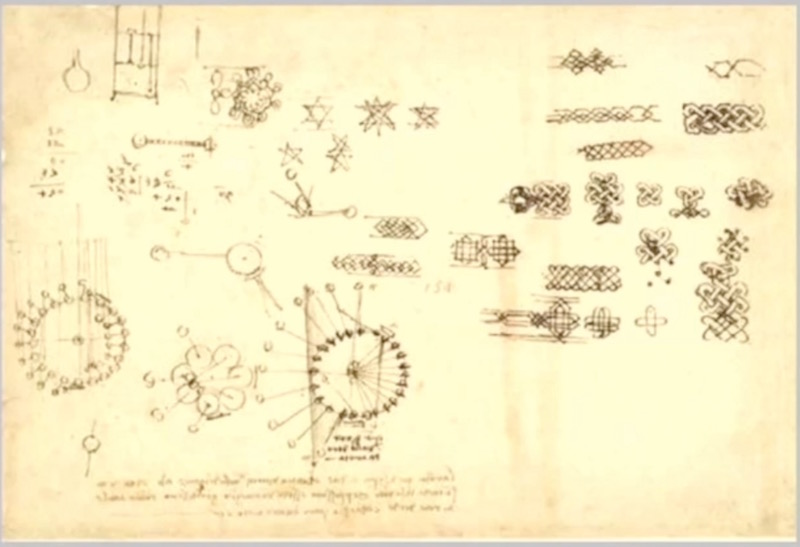
Leonardo da Vinci's perpetual motion manuscript

Leonardo da Vinci sketches and Islamic ceramic patterns
I think Leonardo da Vinci was very interested in mathematical theories in patterns while he was in Venice. He had always been interested in breathtakingly complex weaving patterns, and he designed a series of weaving patterns based on the rounded, curvilinear ornamentation that he used to decorate his academy. He designed with these intricate curved patterns, a process that harnessed the power of geometry to reveal its beauty. When he saw the Islamic patterns in Venice, he realized that there was another way to achieve this goal, which was to use the angular pattern of the squares rotated 45 degrees within the squares. And I think he saw these as reflections of how we observe and record nature, including its various intrinsic structures, rather than as rigid, religious distinctions and oppositions. Of course, Venice has been very strongly influenced by Islamic decorative patterns and patterns, and I don’t think these are necessarily related to the religion of Islam, but to the geometry of nature and art.

The crystal ball and a crystal stone in "Salvator Mundi"
When I was studying natural sciences at Cambridge, I took some courses in geology and remember how fascinated I was by semi-precious stones. And when I saw the sphere in "Salvator Mundi", I thought it was not glass, but probably crystal. There are often some inclusions in crystal stones. They are not bubbles, but irregular gas spaces. I find this actually interesting because this is not a glass ball like some of the Venetian "Saviour" images, but a crystal ball. Oxford geologists also confirmed that the sphere depicted in the painting was made of crystal stone.
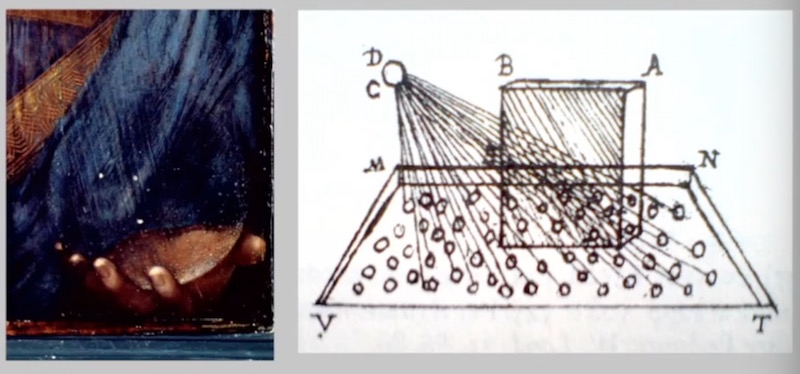
Study of crystal stones and light
Leonardo da Vinci was interested in the optical phenomena produced by these small pores in the crystal ball. He began to think about how these pebbles looked different in different lights, in shadow or in direct light. These optical complex changes were what Leonardo was so fond of, and he discovered that similar phenomena occurred in crystal stones. . Now, we zoom into the crystal ball in "Salvator Mundi" to look at these small details. In the draft shown above, there are many small dots drawn by the pen tip in this way, and when he drew these, he was probably thinking, "What is the most convenient and concise way to draw these small inclusions?" Each dot is made up of a little dark paint and a little light paint, very simple and beautifully done. I think these seemingly random exercises are actually preparations for "Salvator Mundi".

(Upper left) Raphael's "School of Athens" (detail); (right) "Astronomy" (detail), (lower left) "Salvator Mundi" (detail)
Once we know that this is a crystal ball, this brings some interesting implications to the meaning of the painting. The cosmology at that time advocated the concept of the Greek astronomer, cartographer, and geographer Ptolemaeus. In his system, there were some fixed stars that moved together, and all the stars together formed a finite universe. And the boundary of this universe is the edge of the crystal ball. In one of the two paintings by Raphael, the School of Athens, Ptolemy himself is holding a sphere representing the earth, while next to him another philosopher, presumably Zoroas Zoroaster is holding a sphere representing a celestial body. In the same room in the Vatican, another painting on the ceiling shows the Earth at the center of a crystal ball with the symbols of the zodiac painted on its surface. Therefore, we can see that Leonardo da Vinci added another layer of meaning to the fixed theme of "Savior". He wanted to express that it was about the entire universe, about the specific star in the crystal ball. a finite universe. In other words, he translated the word in a very meaningful way, which is a very typical Leonardo da Vinci behavior.
He was very interested in crystal balls and was regarded as an expert on the subject. In the manuscript in the Codex Atlanticus, a cuboid is some kind of crystal utensil, and it is marked next to it that it is made of crystal stone, and it may be a magnifying glass. We don’t know exactly what it was, but we do know that it was made of rock crystal, and his interest in this incredibly beautiful and expensive material is documented as such.
Leonardo da Vinci and optical theory
Another element involved is Leonardo da Vinci's late insights into vision. I previously thought that "Salvator Mundi" was a relatively late work, probably after 1500, but now I think this time range can be narrowed to after 1510. What happened during Leonardo's career was that he came to appreciate the subtlety and complexity of vision.
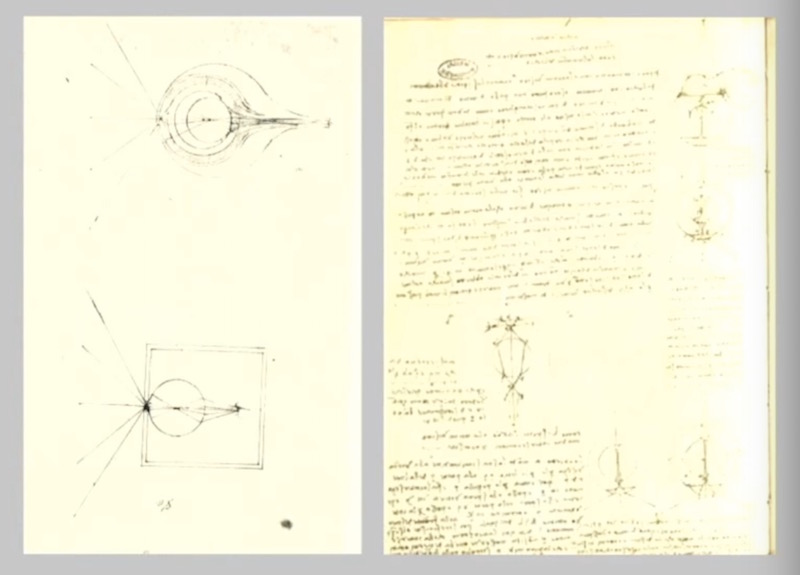
Leonardo da Vinci’s research on the optical system of the human eye
When Leonardo was young, he thought this was a simple matter. The eyes simply received light and recorded it, measuring objects like a two-legged compass or a compass. Later, partly from medieval philosophy and partly from translation, he came into contact with the visual theory of Islamic scholarship. Ibn al-Haytham, the great medieval optician, whom Leonardo da Vinci learned about through his book "De aspectibus" (Latin title "De aspectibus", probably the greatest treatise ever written) When it comes to the working mechanism of the eye, it is actually a very complex optical theory. To this end, Leonardo da Vinci tried to use glass to simulate an eye in a small experiment, filled it with water, and placed a small glass ball in the middle to see if this could create the optical effect he wanted. His final conclusion about the complexity of vision can be found in his manuscript "On the Eye," where he wrote, "The eye cannot know the boundaries of an object, so one cannot see the boundaries of an object with certainty." This is very obvious in his later paintings, such as the "Mona Lisa" where the forms are soft and slightly blurry. These are all products under the influence of this new optical theory, that is, "the eye cannot clearly see the boundaries of any object."

"Mona Lisa" (detail)
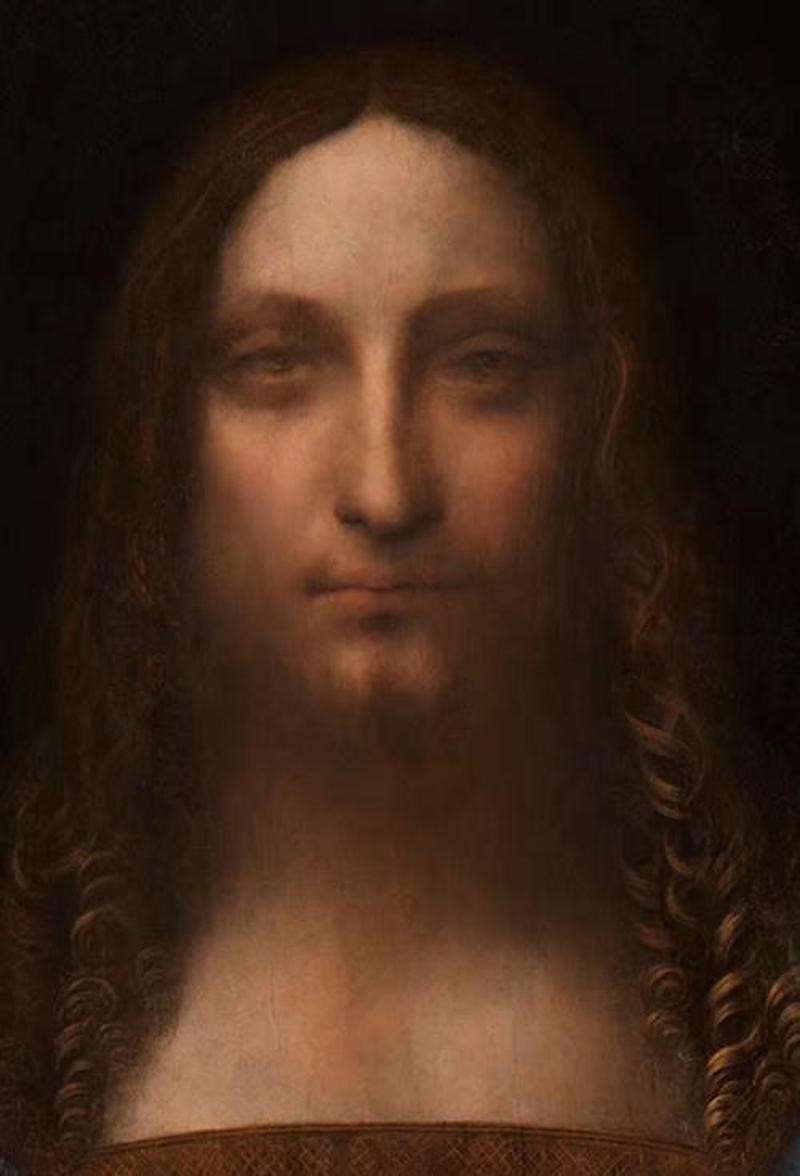
"The Savior" (detail)
If we look at "Salvator Mundi" we see varying degrees of focus, what we call, to use an anachronistic term, "depth of field." His hand closer to us is in an ideal position, not too close, but just in the right position where we can see it quite clearly. The faces of the characters in the painting are slightly further back and become blurred. Here, we can see that Leonardo da Vinci made use of optical theory in "Salvator Mundi". This is more than an optical exploration, though, as he is charting the deepest spiritual core of Christendom. In this regard, he expressed that people cannot really understand it, it is unknowable and invisible. So Christ is to some extent visible to us, but at the same time He is also invisible to us. In the Middle Ages this was known as negative theology, the idea that as mortals we are limited in our perception and understanding. In this way, the ambiguity of form in optical theory and the ignorance of people's theological cognition - the uncertainty about the supreme God and the Son of God - are perfectly integrated.
Leonardo da Vinci is often considered an atheist, but this is not the case. He just believed that everything has limits. In a sketch hidden in the National Gallery in London, the human faces are very blurry, soft and mysterious; in "St John the Baptist" in the Louvre, John's smile suggests spirituality level of knowledge, because He knows the mysteries that we don’t know. Leonardo da Vinci once wrote "Leave the definition of the soul... to the consideration of the monks, who are the fathers of the people and who are inspired to know the mysteries. I call them sacred writings because they are the supreme truth." ”, and there was no irony in his words, he just wanted to say that because our ability to understand as mortals is limited, we cannot enter this sacred realm. Therefore, this technique of blurring the visible and the invisible is a combination of optics and theology, which is very wonderful and a very typical Leonardo da Vinci behavior.
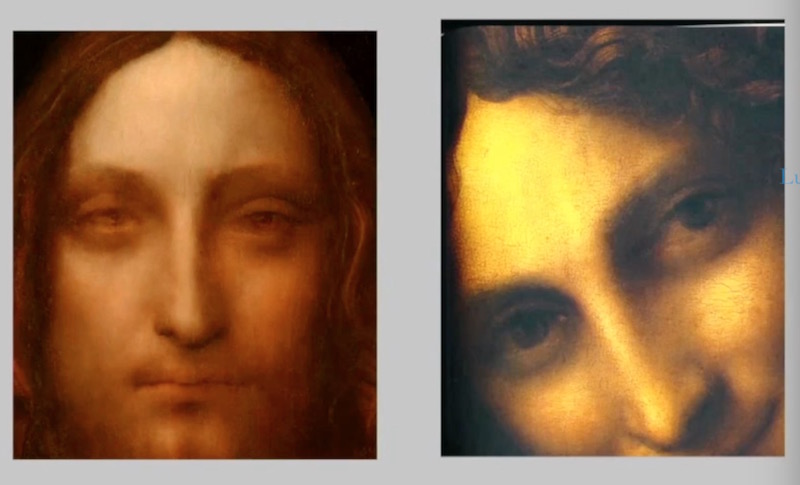
"Salvator Mundi" (detail) and "Saint John the Baptist" (detail)
This is a manifestation of the denial of theology, the essence of mystery. Since the Mona Lisa, all of Leonardo da Vinci's portraits have an unknown quality to them. The Mona Lisa is ambiguous; her smile seems to us more like a joke than a definite meaning. So is John the Baptist. The ultimate source of spiritual and even soul-level knowledge has a mysterious nature, and "Salvator Mundi" is the culmination of Leonardo da Vinci's interpretation of this.
In short, nothing about Leonardo da Vinci is straightforward, and he has always attracted controversy, legend, and most extraordinary historical interest.
Looking forward to the reappearance of "The Savior"
When the painting first arrived in New York, it was sent to the studio of Mario Modestini. As they worked their way through the painting, they discovered how badly it had been damaged. Later, Robert Simon began showing photographs of the painting to a large group of scholars, among whom I was honored to be included. In March 2008, we were invited to the Conservation Studio of the National Gallery in London, England. At the time, the National Gallery was considering an exhibition on Leonardo, and Robert Simon brought the painting over from New York. Many experts were in the room at the time. Next, a debate began. No one said that this was definitely not a work by Leonardo da Vinci, and no one asked us to come up with a definite conclusion. Later rumors made it seem like this was a vote. Privately, I expressed to Robert Simon my wish to conduct research on the painting. I summarized my research plan and mentioned various aspects such as optical issues, theology, crystal stones, and how to draw hair. I didn't say, "I think this is a Leonardo da Vinci," but I said it deserves to be studied in as much detail as possible.

The restoration of "Salvator Mundi" was completed by conservator Dianne Dwyer Modestini of the New York University School of Fine Arts Restoration Center
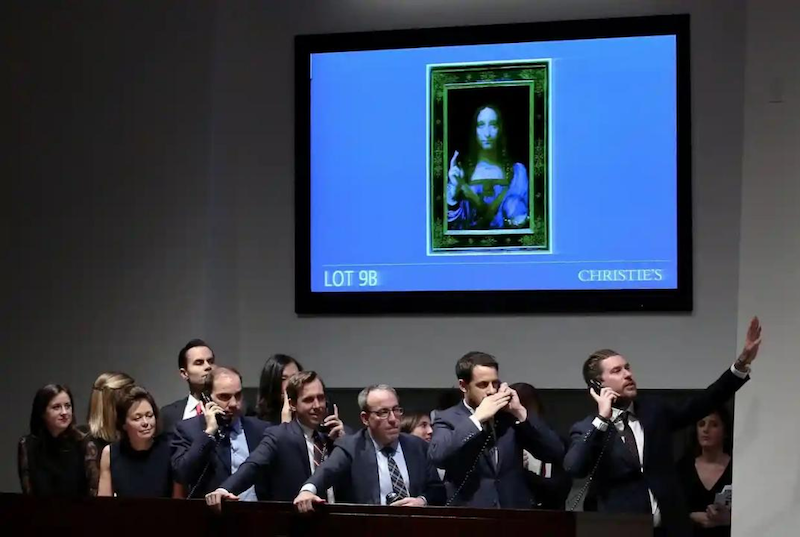
Auction scene at Christie's in New York, November 15, 2017. Image © Peter Foley:EPA-EFE:Rex:Shutterstoc
This is not the end. Perhaps, it is actually the beginning of the end. We still don't know exactly where the painting is or when it will appear. You see, this is the most expensive painting in the world, but I don’t know how to see it. I hope it will one day return to the public eye. It's truly a remarkable painting, and I think it perfectly demonstrates its significance as a great painting, like a religious version of the Mona Lisa.
(Martin Kemp, a well-known art historian and curator, a member of the British National Academy, emeritus professor of the Department of Art History at the University of Oxford, and a Leonardo da Vinci researcher. He studied at the University of Cambridge and the Courtauld Institute of Art in the United Kingdom Studied natural science and art history. Taught at Wolfson College, University of Glasgow, University of St. Andrews, etc. in the UK.)
